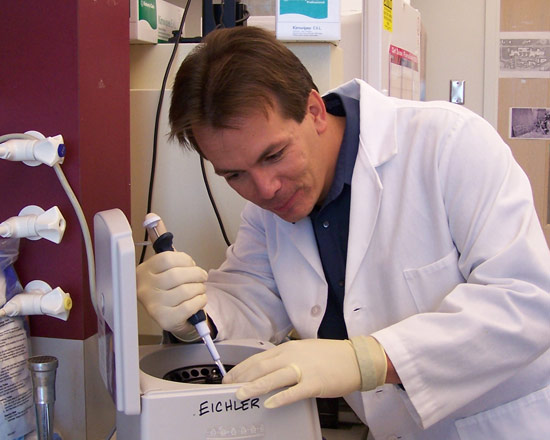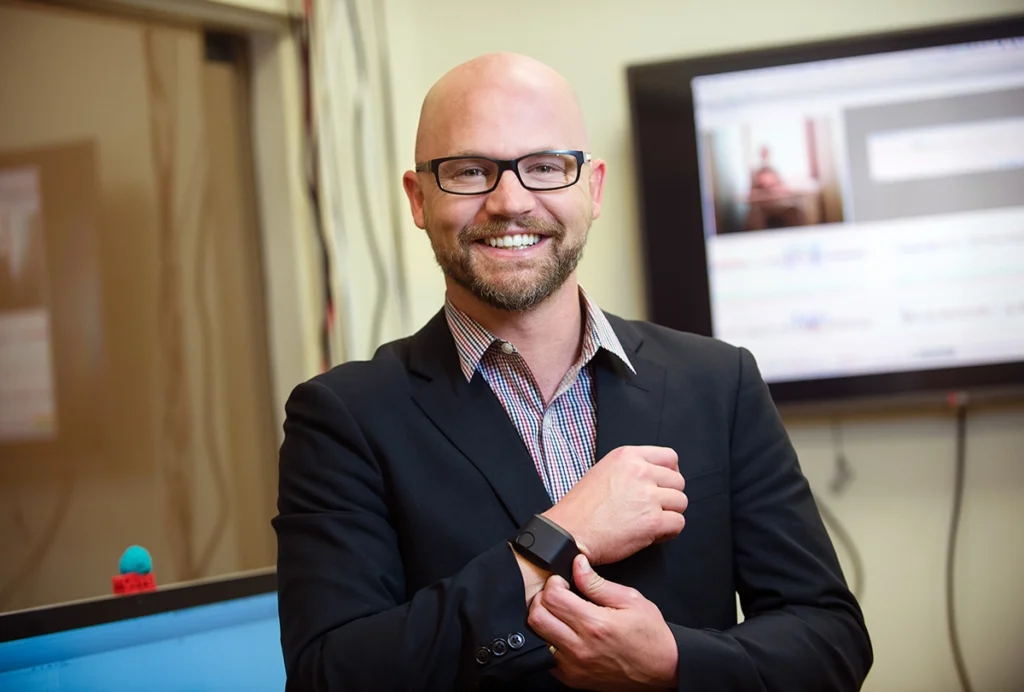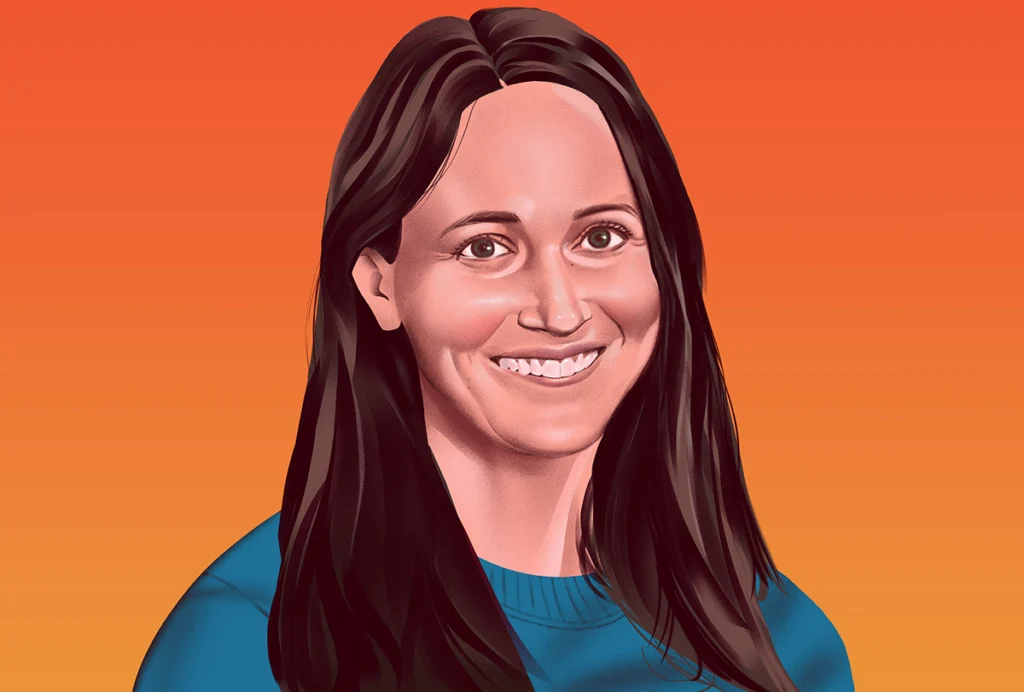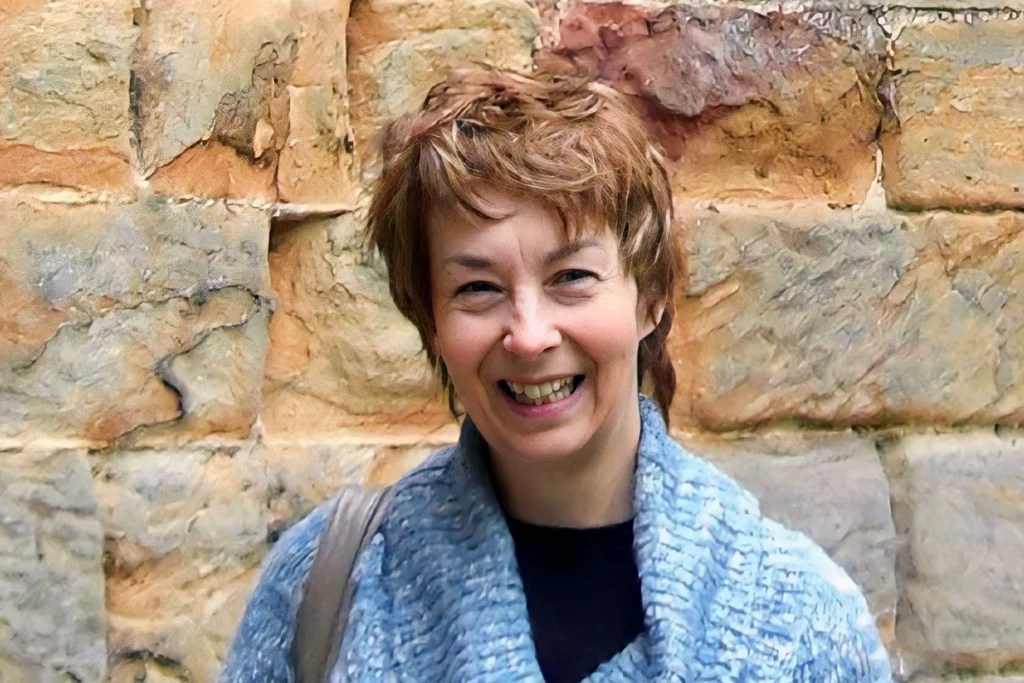Evan Eichler: Following his instincts to autism ‘hotspots’
With an openness to collaboration and a healthy dose of daring, Evan Eichler has turned his offbeat interest in repeat DNA sequences into a new understanding of how genomes evolve, expediting the search for genes disrupted in autism.

Bold moves: Evan Eichler pursues unorthodox ideas.
One day before his interview for a faculty position at Case Western Reserve University, in December 1996, Evan Eichler was wrangling with a decision that, really, should have been made days, or even weeks, earlier: Which job talk to give?
One option was to tell his audience, the entire genetics department, about his work on fragile X syndrome, which is characterized by mental retardation and, often, autism. This was a hot topic because just five years earlier, scientists had discovered that the syndrome stems from the silencing of a single gene, FMR1. As a graduate student, Eichler had studied what makes the gene prone to mutation.
“The other talk was about this crazy duplication idea,” he says, referring to ‘segmental duplications’ — stretches of DNA 10,000 or more nucleotides long, whose sequences are repeated nearly verbatim elsewhere in the genome. Segmental duplications are fixtures of the genome in humans and other organisms.
At the time, many scientists dismissed segmental duplications as useless hiccups in the DNA code. But Eichler recognized that they could instigate genomic change, throwing off the alignment of paternal and maternal chromosomes as they trade bits of DNA during the division of germ cells. This improper positioning leads to missing or extra pieces of DNA, called copy number variations (CNVs), in the resulting sperm and egg cells. When passed on to the new generation, the mutations can also drive evolution.
Unable to decide between the two topics, he asked his wife, Marla, for her opinion. “She said, ‘Do the crazy one. Whatever you actually feel more passionate about, do that one,'” Eichler recalls. So he did. “I went with my instincts instead of thinking through it logically.”
He got the job.
In the decade since, Eichler has continued to follow his instincts — with spectacular success. In 2002, he was the first to map the locations of all segmental duplications in the human genome. He then used that map to identify hotbeds of mutation. With an openness to collaboration and a healthy dose of daring, he has turned his offbeat interest in segmental duplications into a new understanding of how genomes evolve, expediting the search for genes disrupted in disorders such as autism.
“Much of scientific advance comes from these strange ideas,” says Aravinda Chakravarti, director of the Center for Complex Disease Genomics at Johns Hopkins University, who helped recruit Eichler to Case Western Reserve.
“Evan pursued his hypothesis in a very dogged way, with a lot of passion and a huge amount of hard work, at a point in time when many others thought this was a bogus idea,” Chakravarti says.
In the past year, Eichler has turned his attention to the Simons Simplex Collection (SSC), a repository of well-characterized samples from 2,000 children with autism and their families. Rather than screening the entire genome for defects linked to the disorder, he is targeting segmental duplications because of their predisposition to create CNVs. Several studies in the past few years have implicated CNVs in autism1 and other diseases.
“He’s made a compelling case that we should look at these regions for autism [mutations],” Chakravarti says.
A Canadian in Texas:
Early on an overcast October morning in Seattle, Eichler sits in his office at University of Washington. Beyond the open door, machines whirr and hum as his lab members show up for work.
Despite having just returned from a three-day trip to Australia, Eichler brims with energy as he describes his work, occasionally springing up to draw something on a whiteboard littered with older sketches, making the boyish cowlicks above his forehead bounce.
“I’m still close enough to the pulse, the science stuff,” he says about running his lab. “It’s the greatest place to be.”
When he’s not traveling (he made at least 27 trips in 2009), Eichler lives in North Bend, a small community in the foothills of the Cascade Mountains in Washington, with his wife and four children. He skis the nearby slopes, he says, “probably more often than I should.”
No stranger to the outdoors, Eichler was raised on a farm in Manitoba, Canada. He got his first taste of genetics there, breeding angora rabbits with different colored coats for his mother’s yarn. By the time he was in high school, he knew he wanted to study human genetics. But these plans were put on hold when he enrolled at University of Saskatchewan, where the biology curriculum emphasized evolution.
In 1991 he headed to Houston, Texas, to pursue a doctorate in human genetics at Baylor College of Medicine. With his characteristic clarity, he applied to join the lab of David Nelson, who had just discovered that mutations in FMR1 cause fragile X syndrome2.
“[Eichler] came up to me and said, ‘I’d really like to understand how genomes evolve.’ Full stop,” Nelson recalls. “That’s very unusual for a student.”
Unfortunately, the tools weren’t yet ready to study and compare whole genomes. The Human Genome Project had been launched just a year before, and DNA microarray technology was still getting off the ground. Still, Nelson did not discourage him.
“It was so clear that he was very passionate about where he wanted to go,” Nelson says, adding with a laugh that Eichler basically needed something to do in graduate school while he waited for the tools to become available.
FMR1 contains repeating trios of CGG nucleotides, and the number of repeats can vary between parents and offspring. When there are more than 200 repeats, FMR1 gene expression halts, triggering fragile X syndrome. The instability of the repeats fueled Eichler’s interest in whether other parts of the genome are similarly prone to radical changes in the DNA code. “I got fascinated not so much in the gene or what the gene did, but actually the mechanism of mutation,” he says.
For his thesis, Eichler showed that stretches of triplet repeats that are not briefly interrupted by other sequences are particularly vulnerable to gene silencing3.
From his four years in Nelson’s lab, Eichler eventually produced 15 papers, including one on segmental duplication of a piece of the X chromosome4. He also managed to find an evolutionary angle to his research, comparing the sequence of FMR1 across 44 different species5, wrangling samples of platypus DNA from Australia and bat DNA from Texas.
Maps of instability:
After Baylor, Eichler started a postdoctoral fellowship at Lawrence Livermore National Laboratory in California, where he sequenced parts of chromosome 19, which is packed with segmental duplications.
In 2000, from his own lab at Case Western Reserve, he finally got a genome-wide view of segmental duplications. As the publicly-funded Human Genome Project finished its first draft, the organizers tapped Eichler to map the duplications.
“I said, ‘Well, I’m all set up, I can do this now,’ — which was a total lie,” he says, chuckling.
Eichler quickly cobbled together 15 computers to analyze the sequences. After a false start, followed by a tricky collaboration with both the public venture and the competing private biotech company, Celera, he and his team precisely located the repeated sequences in the human genome6.
Although segmental duplications were once considered rare, Eichler’s search showed that they make up more than five percent of the genome, and occur on all chromosomes. What’s more, unlike in most mammals, the majority of duplications in humans are interspersed, meaning that they have blocks of unique sequence between them.
Eichler predicted that an interspersed duplication would be a ‘hotspot’ prone to genetic accidents, and he wanted to systematically search these hotspots to fast-track the discovery of disease-linked CNVs.
This targeted search required a collaboration, and Eichler forged one at a pub in Oxford, England, during a conference in 2000. Over a beer, he convinced geneticists Daniel Pinkel and Donna Albertson to help him develop a DNA microarray to detect CNVs in these hotspots.
“He’s driven by biological questions, and he looks for ways to approach those wherever he can find them,” says Pinkel, professor of laboratory medicine at University of California, San Francisco. “If that takes collaborations, he does it.”
The microarray the researchers developed probed 130 hotspots, consisting of segmental duplications separated by 50 to 10,000 kilobases of unique DNA sequence. Standard microarrays typically miss these repeat-rich regions because the signals are harder to interpret than those from unreplicated, unique portions of the genome.
The results, published in 2006, revealed CNVs that can cause mental retardation in a sizable five percent of children with the condition7. “We hit pay dirt there,” Eichler says.
The high yield confirmed that these hotspots are prone to mutate, and that screening them increases the likelihood of finding ‘recurrent’ mutations that crop up in more than one person.
Scientists have had not much luck finding recurrent mutations, making it hard to definitively link a particular genetic defect to a disease. But in Eichler’s study, 4 of the 290 children have the same mutation: a small deletion on chromosome 17. This argues strongly that the mutation caused their mental retardation and unusual facial features.
This hotspot approach also discovered previously unrecognized phenotypic similarities among people carrying the same mutation. For example, Eichler’s team has documented a recurrent deletion in chromosomal region 15q24 in multiple individuals who have mental retardation combined with delayed growth8, and a recurrent deletion in 15q13.3 in individuals with mental retardation combined with seizures9.
“It’s not like its magical,” Eichler says about the abundance of disease-related mutations in his hotspots. “Lots of areas of the genome can result in disease if you delete or duplicate them. It’s just that we’re sampling regions we think are really hot for new mutation.”
On the flipside:
Eichler is bringing his methodology to autism, with a plan to screen up to 800 hotspots in individuals from the SSC.
Most of these will be what Eichler calls ‘mini- or micro-hotspots’ — regions that contain a unique sequence as small as one kilobase between duplications. He suspects that CNVs found in the collection will be small, affecting only a few genes, because participants have narrowly defined autism that doesn’t usually include other difficulties, such as intellectual disability or physical abnormalities.
“And the beauty of it is, if we do [find CNVs in] these minis and micros, we get it down to the level of the gene practically instantaneously,” he says.
Eichler then plans to widen his search to look at a broadly defined population of people with developmental delays, because the same mutations could take on different forms.
For example, the 15q13.3 deletion he identified in cases of mental retardation with seizures has also been related to epilepsy10, schizophrenia11, autism12 and, in some cases, no disease at all13.
Screening a group burgeoning with an array of symptoms might seem like another one of Eichler’s offbeat ideas. After all, many genetic studies go to great lengths to limit the variability in their study population.
But studying a diverse population is a valuable “flipside” to gene discovery because it acknowledges the winding and variable pathway that leads from a particular mutation to behavior, says Matthew State, associate professor of child psychiatry and genetics at Yale University. State is canvassing the entire genomes of SSC individuals for CNVs, which he then plans to sequence to pinpoint autism-related mutations.
“We’ve got to be humble about our phenotypic categorizations,” State says, pointing out that they are made without an understanding of the genetics behind them.
Eichler plans to initially identify CNVs in the SSC’s tightly-defined autism group, and then look for the same mutations in the developmentally delayed group. This ‘genotype-first’ approach will help find the variety of phenotypes that can stem from the same mutation, and promises to blur the distinction between various brain disorders, he says.
If that sounds like another one of Eichler’s crazy ideas, chances are it will pay off in spades.
References:
- Sebat J. et al. Science 316, 445-449 (2007) PubMed
- Pieretti M. et al. Cell 66, 817-822 (1991) PubMed
- Eichler E.E. et al. Nat. Genet. 8 88-94 (1994) PubMed
- Eichler E.E. et al Hum. Mol. Genet. 5, 899-912 (1996) PubMed
- Eichler E.E. et al. Nat. Genet. 11, 301-308 (1995) PubMed
- Bailey J.A. et al. Science 297, 1003-1007 (2002) PubMed
- Sharp A.J. et al. Nat. Genet. 38, 1038-1042 (2006) PubMed
- Sharp A.J. et al. Hum. Mol. Genet. 16, 567-572 (2007) PubMed
- Sharp A.J. et al. Nat. Genet. 40, 322-328 (2008) PubMed
- Helbig I. et al. Nat. Genet. 41, 160-162 (2009) PubMed
- Stefansson H. et al. Nature 455, 232-236 (2008) PubMed
- Pagnamenta A.T. et al. Eur. J. Hum. Genet. 17, 687-692 (2008) PubMed
- van Bon B.W. et al. J. Med. Genet. 46, 511-523 (2009) PubMed
Explore more from The Transmitter

Crowdsourcing to curb aggression in autism: Q&A with Matthew Goodwin

Brain connectivity and letting the data speak with Emily Finn
